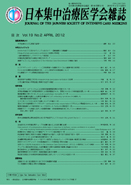Volume 19, Issue 2
Displaying 1-33 of 33 articles from this issue
- |<
- <
- 1
- >
- >|
HIGHLIGHTS IN THIS ISSUE
-
2012 Volume 19 Issue 2 Pages 154-156
Published: April 01, 2012
Released on J-STAGE: October 01, 2012
Download PDF (596K) -
2012 Volume 19 Issue 2 Pages 156-158
Published: April 01, 2012
Released on J-STAGE: October 01, 2012
Download PDF (470K) -
2012 Volume 19 Issue 2 Pages 158-160
Published: April 01, 2012
Released on J-STAGE: October 01, 2012
Download PDF (470K) -
2012 Volume 19 Issue 2 Pages 160-162
Published: April 01, 2012
Released on J-STAGE: October 01, 2012
Download PDF (468K) -
2012 Volume 19 Issue 2 Pages 162-164
Published: April 01, 2012
Released on J-STAGE: October 01, 2012
Download PDF (468K)
REVIEW ARTICLES
-
2012 Volume 19 Issue 2 Pages 165-175
Published: April 01, 2012
Released on J-STAGE: October 01, 2012
Download PDF (677K) -
2012 Volume 19 Issue 2 Pages 177-184
Published: April 01, 2012
Released on J-STAGE: October 01, 2012
Download PDF (401K) -
2012 Volume 19 Issue 2 Pages 185-189
Published: April 01, 2012
Released on J-STAGE: October 01, 2012
Download PDF (322K)
ORIGINAL ARTICLES
-
2012 Volume 19 Issue 2 Pages 191-196
Published: April 01, 2012
Released on J-STAGE: October 01, 2012
Download PDF (351K) -
2012 Volume 19 Issue 2 Pages 197-202
Published: April 01, 2012
Released on J-STAGE: October 01, 2012
Download PDF (279K)
CASE REPORTS
-
2012 Volume 19 Issue 2 Pages 203-206
Published: April 01, 2012
Released on J-STAGE: October 01, 2012
Download PDF (347K) -
2012 Volume 19 Issue 2 Pages 207-210
Published: April 01, 2012
Released on J-STAGE: October 01, 2012
Download PDF (408K) -
2012 Volume 19 Issue 2 Pages 211-214
Published: April 01, 2012
Released on J-STAGE: October 01, 2012
Download PDF (437K) -
2012 Volume 19 Issue 2 Pages 215-217
Published: April 01, 2012
Released on J-STAGE: October 01, 2012
Download PDF (306K) -
2012 Volume 19 Issue 2 Pages 219-223
Published: April 01, 2012
Released on J-STAGE: October 01, 2012
Download PDF (360K) -
2012 Volume 19 Issue 2 Pages 225-229
Published: April 01, 2012
Released on J-STAGE: October 01, 2012
Download PDF (474K) -
2012 Volume 19 Issue 2 Pages 231-235
Published: April 01, 2012
Released on J-STAGE: October 01, 2012
Download PDF (406K) -
2012 Volume 19 Issue 2 Pages 237-240
Published: April 01, 2012
Released on J-STAGE: October 01, 2012
Download PDF (325K)
RAPID PUBLICATION
-
2012 Volume 19 Issue 2 Pages 241-243
Published: April 01, 2012
Released on J-STAGE: October 01, 2012
Download PDF (257K)
BRIEF REPORTS
-
2012 Volume 19 Issue 2 Pages 245-246
Published: April 01, 2012
Released on J-STAGE: October 01, 2012
Download PDF (287K) -
2012 Volume 19 Issue 2 Pages 247-248
Published: April 01, 2012
Released on J-STAGE: October 01, 2012
Download PDF (92K) -
2012 Volume 19 Issue 2 Pages 249-250
Published: April 01, 2012
Released on J-STAGE: October 01, 2012
Download PDF (220K) -
2012 Volume 19 Issue 2 Pages 251-252
Published: April 01, 2012
Released on J-STAGE: October 01, 2012
Download PDF (285K) -
2012 Volume 19 Issue 2 Pages 253-254
Published: April 01, 2012
Released on J-STAGE: October 01, 2012
Download PDF (296K) -
2012 Volume 19 Issue 2 Pages 255-256
Published: April 01, 2012
Released on J-STAGE: October 01, 2012
Download PDF (247K) -
2012 Volume 19 Issue 2 Pages 257-258
Published: April 01, 2012
Released on J-STAGE: October 01, 2012
Download PDF (280K) -
2012 Volume 19 Issue 2 Pages 259-260
Published: April 01, 2012
Released on J-STAGE: October 01, 2012
Download PDF (254K) -
2012 Volume 19 Issue 2 Pages 261-262
Published: April 01, 2012
Released on J-STAGE: October 01, 2012
Download PDF (330K) -
2012 Volume 19 Issue 2 Pages 263-264
Published: April 01, 2012
Released on J-STAGE: October 01, 2012
Download PDF (239K) -
2012 Volume 19 Issue 2 Pages 265-266
Published: April 01, 2012
Released on J-STAGE: October 01, 2012
Download PDF (234K) -
2012 Volume 19 Issue 2 Pages 267-268
Published: April 01, 2012
Released on J-STAGE: October 01, 2012
Download PDF (298K)
INVESTIGATION REPORTS
-
2012 Volume 19 Issue 2 Pages 269-272
Published: April 01, 2012
Released on J-STAGE: October 01, 2012
Download PDF (297K) -
2012 Volume 19 Issue 2 Pages 273-276
Published: April 01, 2012
Released on J-STAGE: October 01, 2012
Download PDF (288K)
- |<
- <
- 1
- >
- >|
